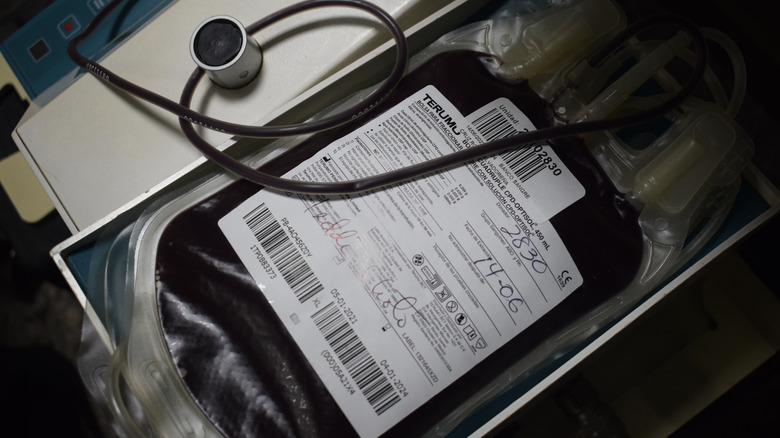Is It Safe To Exercise After Giving Blood?
If you're the type who seeks out every opportunity to help out your fellow humans, you've most likely thought about donating blood. Maybe you've even done it already! There are a number of personal and professional reasons why you might consider donating blood.
According to the Red Cross, blood donations can help individuals in all demographics with various diseases and injuries. Medical News Today also cites potential mental health benefits that come from the altruistic behavior of freely providing assistance to fellow humans with no expected gain. Unfortunately, UnityPoint Health notes that approximately 90% of eligible blood donors do not actively donate blood, creating a consistent need for donors. They go further by stating that 90% of people who live to the age of 70 will need blood at some point in their life.
Whole blood donations can be done up to six times a year, spaced 56 days apart (via Red Cross). There are also a few other ways to donate, including platelet donation and plasma donation. Each donation process has different limitations, such as the time required and the number of donations allowed per year.
How does blood donation work?
The blood donation process begins with a screening process. The entire process takes about an hour to complete; however, the donation itself takes around 10 minutes for most individuals (via Red Cross). You'll answer a series of questions and be given some tests (such as temperature, pulse, and blood pressure) to determine if you are a healthy candidate for donation.
The typical whole blood donation is for approximately one pint, notes the Red Cross. While this is a safe amount to be removed from a healthy individual, there can be some minor side effects. Following the donation, the overall red blood cell count and oxygen levels in the blood will be lowered while the body quickly works to replace the depleted red blood cells (via OneBlood).
Some individuals may feel queasy, light-headed, or fatigued, particularly if they haven't had proper nutrition prior to the donation. The good news is that while these symptoms can be unpleasant, they are short-lived, according to OneBlood.
Some donation facilities offer small snacks and/or juice if you're feeling a little shaky or nauseous following your donation. You'll be monitored in a rested position until you feel ready to leave (via Medical News Today).
Can you exercise after giving blood?
Just like you shouldn't run your car when it's low on oil, your body shouldn't be pushed when you're a pint down on blood. After giving blood, your body needs some time to recover before you resume normal exercise. The Red Cross advises that after giving blood, you take the rest of the day to relax and avoid any type of vigorous activity. The World Health Organization goes further and suggests avoiding sports and strenuous activities for 48 hours, per Medical News Today.
This is for a few reasons. Whole blood donations cause a temporary depletion of red blood cells in the body (via OneBlood). This has an impact on the factors like oxygen levels, hydration, and iron levels, according to Medical News Today. This can impact your ability to perform in athletic activities as your body is diminished. It can even put you at risk of injury, warns LiveStrong.
Additionally, while the body does work quickly to replace those red blood cells, individuals who participate regularly in endurance activities may find that their performance is affected for several weeks, according to LiveStrong. Taking a few precautions when donating blood like avoiding alcohol and caffeine, enjoying a healthy and balanced diet, and staying hydrated can help speed up your recovery time.



